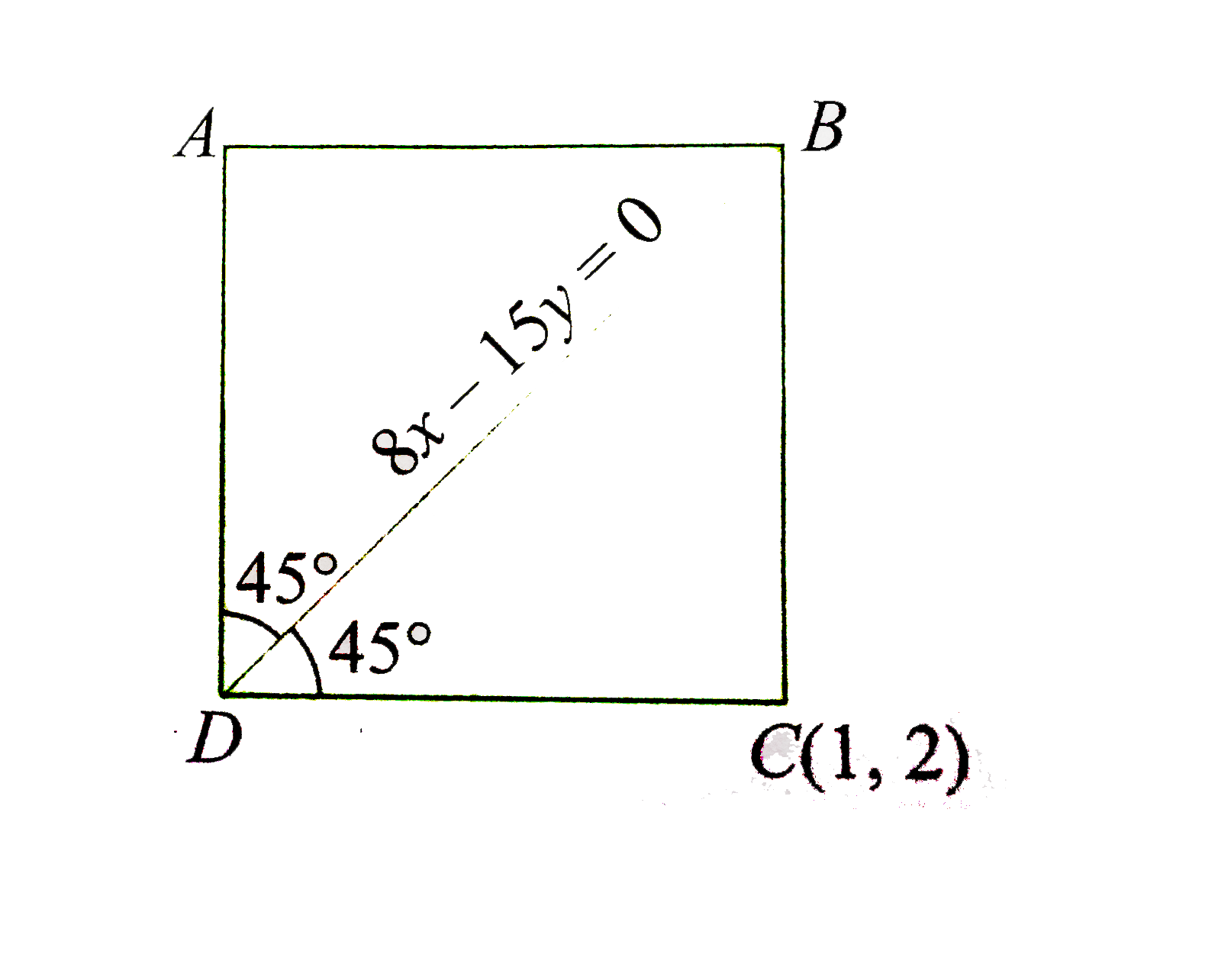If one of the sides of a square is 3x−4y−12=0 and the center is (0,0) , then find the equations of the diagonals of the square.Solution in Tamil
7x-8y+9=0, 8x+7y-22=0
9x-8y+7=0.8x+9y-26=0
23x-7y-9=0,7x+23y-53=0
none of these
The correct Answer is:C

The slope of BD is 8/15 and the angle made by BD with DC and BC is 45∘. So, let the slope of DC be m. Then,
tan45∘=±m−8151+815m
or (15+8m)=±(15m−8)
or m=237 and −723
Hence, the equations of DC and BC are
y−2=237(x−1)
or 23x-7y-9=0
and y−2=−723(x−1)
or 7x+23y-53=0
Topper's Solved these Questions
- STRAIGHT LINESBOOK - CENGAGECHAPTER - STRAIGHT LINESEXERCISE - Exercise (Multiple)
30 Videos
- STRAIGHT LINESBOOK - CENGAGECHAPTER - STRAIGHT LINESEXERCISE - Exercise (Comprehension)
27 Videos
- STRAIGHT LINESBOOK - CENGAGECHAPTER - STRAIGHT LINESEXERCISE - Exercise 2.6
5 Videos
- STRAIGHT LINEBOOK - CENGAGECHAPTER - STRAIGHT LINEEXERCISE - Multiple Correct Answers Type
8 Videos
- THEORY OF EQUATIONSBOOK - CENGAGECHAPTER - THEORY OF EQUATIONSEXERCISE - JEE Advanced Previous Year
9 Videos
Similar Questions
If P is a point (x,y) on the line y=−3x such that P and the point (3, 4) are on the opposite sides of the line 3x−4y=8, then x>815 (b) x>85 y<−85 (d) y<−815
View SolutionLet L be the line belonging to the family of straight lines (a+2b) x+(a-3b)y+a-8b =0, a, b ∈R, which is the farthest from the point (2, 2).
Area enclosed by the line L and the coordinate axes is
View SolutionIf aandb are two arbitrary constants, then prove that the straight line (a−2b)x+(a+3b)y+3a+4b=0 will pass through a fixed point. Find that point.
View SolutionThe point P(α,α+1) will lie inside the triangle whose vertices are A(0,3),B(−2,0) and C(6,1) if
View SolutionQ. Let p and q real number such that p≠0,p2≠q and p2≠−q. if α and β are non-zero complex number satisfying α+β=−p and α3+β3=q, then a quadratic equation having αβ and βα as its roots is
View SolutionIf one of the sides of a square is 3x−4y−12=0 and the center is (0,0) , then find the equations of the diagonals of the square.
View SolutionIf one sides of a Square is 3x−4y−12=0 and the center is (0;0) ; then find the equation of the diagonals of the square.
View SolutionThe equations of two sides of a square are 3x+4y−5=0and3x+4y−15=0. The third side has a point (6, 5) on it. Find the equation of this third side and the remaining side of the square.
View SolutionOne diagonal of a square is 3x-4y+8=0 and one vertex is (-1,1), then the area of square is
View SolutionThe equation of the diagonal AC of a square ABCD is 3x+4y+12=0 . Find the equation of BD , where D is (2,−3) .
View SolutionA vertex of a square is at the origin and its one side lies along the line 3x-4y-10=0. Find the area of the square.
View SolutionJoint equation of the diagonals of the square formed by the pairs of lines xy+4x−3y−12=0 and xy−3x+4y−12=0, is
View SolutionIf one of the sides of a square is 3x-4y-12 = 0 and the center is (0,0), then find the equations of the diagonals of the square.
View SolutionIf one of the sides of a square is 3x−4y−12=0 and the center is (0,0) , then find the equations of the diagonals of the square.
View SolutionOne diagonal of a square is 3x-4y+8=0 and one vertex is (-1,1), then the area of square is
View SolutionThe combined equation of the diagonals of the square formed by the pairs of lines xy+4x−3y−12=0andxy−3x+4y−12=0 is
View Solution
